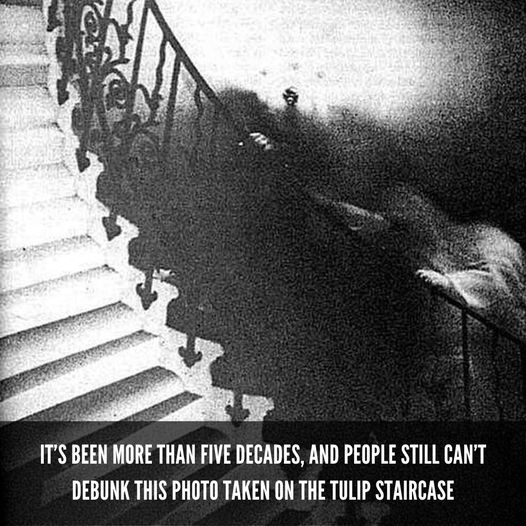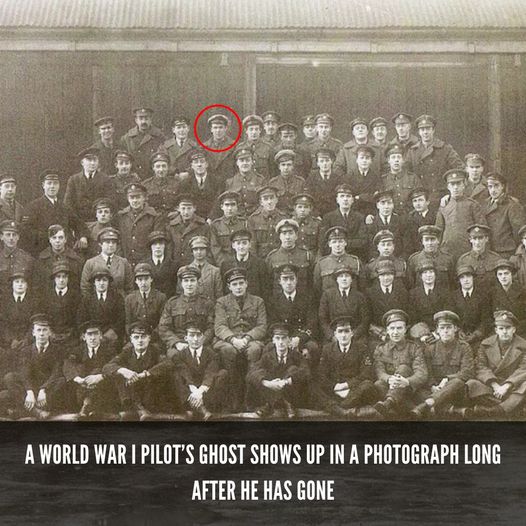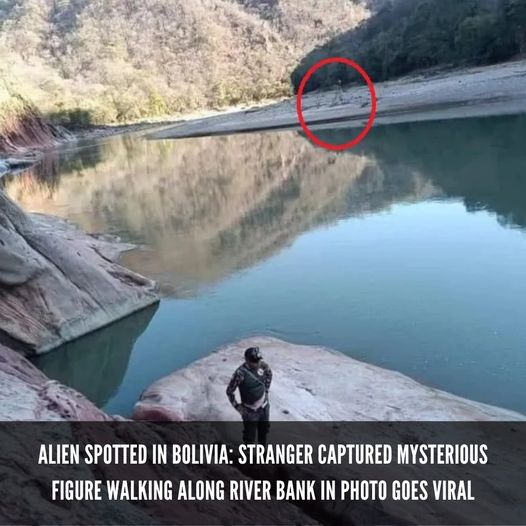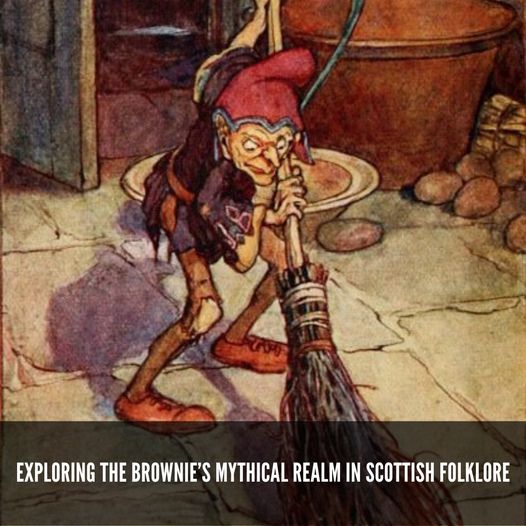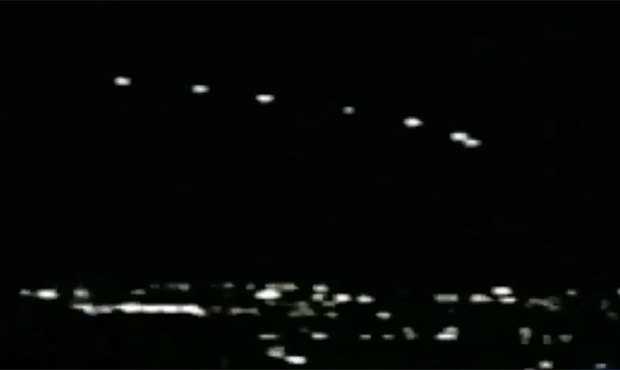Creepy ghost images have been caught on camera at historical sites around the world, but most of those ghostly pictures—bizarre as they may be—have ultimately been proven easy to recreate through photo manipulation and, therefore, easy to debunk. However, believers maintain that a picture taken on the Tulip Staircase in the Queen’s House, part of the National Maritime Museum in London, might actually be one of a very few real ghost photos. Unlike scores of other pictures that contain ghosts (according to their photographers), the Tulip Staircase ghost picture, taken in 1966, has not been debunked to this day. Experts who’ve analyzed the photograph have confirmed that regardless of what its ephemeral subject really is, the picture has not been tampered with, and neither its photographers nor the senior photographer at the National Maritime Museum have been able to recreate it.
The Tulip Staircase picture has flummoxed skeptics and believers alike since catching the eye of one of the world’s oldest paranormal research organizations. Though there is no concrete evidence that specifically identifies the figure caught on camera as a ghost, no one can deny that whatever it is, it’s both very real and ghoulishly unsettling. What’s more, even before the picture was taken, the 400-year-old Queen’s House had earned a reputation every bit as mysterious as the photo. Staff members have reported phantom footsteps, touches, and even singing, and several bloody rumors of the building’s past lend more credence to the idea that the National Maritime Museum may truly have one visitor who hasn’t left for a very, very long time. For more information about the Tulip Staircase ghost and the haunted history of the Queen’s House, check out the list below.
-
The Photographer Only Saw The Ghostly Form After Developing The Picture

Photo: Rev. Ralph Hardy / Pinterest
The Tulip Staircase picture was taken by Reverend Ralph W. Hardy during a visit to the National Maritime Museum in 1966. Hardy was visiting with his wife, who had recently seen a lovely picture of the staircase in a magazine and wanted to try to take a similar one. When the couple reached the Queen’s House, they were disappointed to see that the staircase was roped off at the bottom—meaning that they wouldn’t be able to recreate the picture Mrs. Hardy had seen in the magazine. Instead, Rev. Hardy decided to take a picture from underneath the staircase. Neither Rev. Hardy nor his wife suspected that there was anything strange about the Queen’s House—or the photo they took there—until they returned home to British Columbia and developed the photographs from their trip. All the photographs were completely ordinary except one: the picture Rev. Hardy had taken of the Tulip Staircase, which had been empty at the time the photo was taken, clearly showed a translucent figure wearing a dark hooded robe gripping the banister.
-
Ghost Hunters Staked Out The Museum And Heard Things They Couldn’t Explain
The Hardys showed the developed pictures from their trip—including the Tulip Staircase picture—to many of their friends in British Columbia. One of those friends just so happened to have a cousin, Hector McQueen, who was a member of the Ghost Club, one of the oldest paranormal societies in the world. McQueen passed the photo on to the other members of the club, and after corresponding with the Hardys through McQueen’s cousin, the Ghost Club organized an investigation and séance to be held in the Queen’s House on July 24, 1967. The investigation included members of the Ghost Club as well as the museum’s senior photographer and a sound engineer. During the investigation, the Ghost Club used a variety of testing methods and sensory equipment, including atmospheric gauges, audio and video recording equipment, and vibration trackers. While the Ghost Club didn’t manage to find the Tulip Staircase ghost, they certainly didn’t find nothing. Members smelled something that resembled wet stone and heard the sounds of a baby crying, a bell ringing, and disembodied footsteps in the area close to the Tulip Staircase.
-
Even Kodak Confirmed That The Photograph Is Genuine

Photo: Casey Stinnett / via flickr / CC BY 2.0
After receiving the picture from Rev. Hardy and his wife, the Ghost Club, in addition to scheduling a séance at the Queen’s House, began to conduct an investigation into whether or not the photograph could be a fake. During this investigation, Peter Underwood, president of the Ghost Club at the time, learned that the Hardys had been corresponding with Brian Tremain, the senior photographer at the National Maritime Museum, and had sent them information about the camera they had used to take the picture. The Hardys, through a friend in Vancouver who was a friend of a Ghost Club member, sent the same information to Underwood; they also sent along the original negative as well as the negatives of the pictures taken before and after it. Underwood sent these negatives, along with the camera information, to Kodak for analysis. Employees at Kodak concluded that the photo had not been tampered with or double exposed. According to Kodak, the only possible explanation was that someone had to have been on the stairs when the picture was taken… except that no one had been there at all.
-
No One Has Been Able To Reproduce The Photo
Just about a year after the Hardys visited the Queen’s House and took their infamous picture, Rev. Hardy wrote to the National Maritime Museum’s senior photographer, Brian Tremain, with detailed information about the make of his camera. One month later, the Hardys came back to London and met with Tremain at the museum. Together, they agreed to try and reproduce the photograph. By this time, experts at Kodak had pronounced the photo genuine and claimed that the only explanation for the figure in the photo could be that someone had been on the stairs at the time, so Tremain and the Hardys decided to see how such a picture could be taken of a real person. However, after “yards of film,” they were still unable to replicate the effect seen in the original photograph.
-
The Staircase Was Completely Empty When The Picture Was Taken

Photo: Tony Hisgett / via flickr / CC BY 2.0
Experts who examined the Tulip Staircase picture stated that they were sure it hadn’t been tampered with or manipulated—meaning that the figure caught in the picture must have been present when the picture was taken. One problem: No one was there when the photo was taken. On the day the Hardys visited the Queen’s House, the entrance to the Tulip Staircase was blocked off, and visitors were not allowed to go up the stairs—in fact, that was why Rev. Hardy took the picture from underneath the staircase rather than from the top, as he and his wife had originally intended. National Maritime Museum senior photographer Brian Tremain confirmed that he had not seen anyone trying to climb the staircase while the Hardys had been shooting. What’s more, even if the staircase had been accessible to the public, it would have been very unlikely that museum attendants would have allowed anyone to pose or play on the staircase dressed in the type of hooded cloak or robe worn by the ghostly picture in Rev. Hardy’s photo. The most rational explanation for the photograph, it turned out, was completely irrational. There was simply no one there to photograph… at least, no one that anyone could see.
-
A Museum Attendent Saw Another Ghostly Apparition Not Long Ago
Photo: Paul Townsend / via flickr / CC BY-SA 2.0
A gallery assistant at the Queen’s House, Tony Anderson, claimed that on May 20, 2002, he saw a ghost float across the balcony on the top floor of the building. According to Anderson, he had been talking with two other staff members when he heard a door close and saw a figure “glide” across the balcony and disappear mysteriously through a wall. Anderson and the two other employees allegedly hurried into the bedroom where they assumed the figure had gone, and the three of them arrived just in time to see it float through the ante-room and then vanish through the wall again. All three of them claimed to have suddenly felt cold while they watched the figure. The spectral visitor, according to Anderson, was wearing a gray or white crinoline dress.
-
One Clairvoyant Visited The Museum And Had A Nightmarish Vision
Photo: cydarianna / via flickr / CC BY-SA 2.0
Peter Underwood, then president of English paranormal research organization, the Ghost Club, corresponded with the Hardys, the museum’s senior photographer, and employees at Kodak before publishing the story of the ghostly picture in a book of haunted locations in London. A friend of Underwood’s, a medium named Trixie Allingham, decided to go and have a look in the Queen’s House for herself. The experience she described to Underwood was far from idyllic. According to Allingham, she experienced a vision of two people talking beneath the Tulip Staircase: one jealous woman explaining to a confidante that her husband had not been faithful to her. The woman in Allingham’s vision allegedly told her co-conspirator that she was going to to lure her husband’s mistress to the house and then murder her on the stairs. Allingham’s vision ended with blood dripping down the stairs of the Tulip Staircase.
-
Several Bloody Stories Surround The Balcony At The Queen’s House
Photo: Jo Naylor / via flickr / CC BY 2.0
The balcony and staircase where the Hardys captured a mysterious figure on film were the subject of more than a few blood-curdling stories even before the photo became famous. Whether or not the bizarre subject of the photograph is actually a ghost, if these stories are to be believed, inexplicable sightings are far from the creepiest thing to have happened on the balcony and staircase of the Queen’s House. One story tells of a couple who once lived together on the first floor at the top of the staircase. When the couple got into a serious and violent argument, their infant son fell over the balcony to his death. It’s also said that in the 1600s, a house maid toppled over the balcony to her death—but she never left. Many visitors to the National Maritime Museum have reported seeing the spectral figure of a woman mopping a pool of blood off the floor at the bottom of the staircase.
According To Staff, The Museum Has Been Haunted For Years
Ghost sightings at the Queen’s House aren’t just confined to the area near the Tulip Staircase. If employees are to be believed, the museum is teeming with ghosts. The manager of the Queen’s House, Maria Blysinsky, says that employees have been reporting strange things happening in the museum after hours for years. Security guards have had numerous inexplicable experiences in the passages underneath the museum, including phantom taps on the shoulder and doors slamming shut of their own accord. One guard was reportedly unable to open a door in one of the below ground passageways, so they went to ask a coworker for help; when they returned, the door was nowhere to be found. Other unsettling phenomena reported at the museum include the disembodied sounds of childlike voices singing, footsteps that stop as abruptly as they begin, and a nebulous feeling of anxiety somehow connected with the doorway at the top of the Tulip Staircase.
-
The National Maritime Museum Is Old Enough To Be Full Of Ghosts
Photo: Tony Hisgett / via flickr / CC BY 2.0
The Queen’s House, where the photograph was taken, is about 400 years old—it’s not much of a stretch to imagine that it might have picked up a few ghostly residents along the way. The building was designed by an architect named Inigo Jones at the request of King James I, who wanted to give it to his queen as a gift; unfortunately, she died before it was completed. Ultimately, James I’s son, King Charles I, presented it to his own wife, Henrietta Maria of France. In the 1690s, the palace surrounding the Queen’s House became a home for retired Royal Navy sailors until, in the early 1700s, it began to be used as the Royal Naval College. Eventually, the naval college moved from Greenwich to Suffolk, and in 1934, it was officially reopened as the National Maritime Museum. The Queen’s House has seen centuries of sailors, students, and servants climb the Tulip Staircase—and maybe, just maybe, a few of them stuck around.
